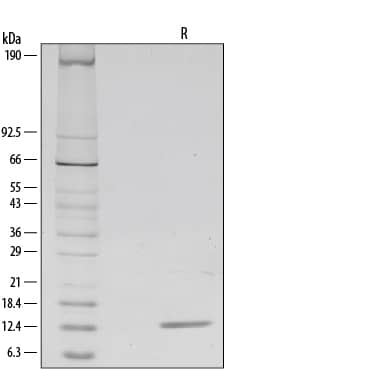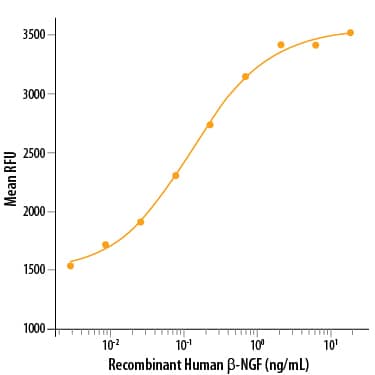Recombinant Human beta-NGF Protein Best Seller
R&D Systems, part of Bio-Techne | Catalog # 256-GF

Key Product Details
Product Specifications
Source
Ser122-Ala241
Purity
Endotoxin Level
N-terminal Sequence Analysis
Predicted Molecular Mass
SDS-PAGE
Activity
The ED50 for this effect is 0.2-2 ng/mL.
Reviewed Applications
Read 3 reviews rated 4.7 using 256-GF in the following applications:
Scientific Data Images for Recombinant Human beta-NGF Protein
Recombinant Human beta-NGF Protein Bioactivity
Recombinant Human beta-NGF (Catalog # 256-GF) stimulates cell proliferation of the TF-1 human erythroleukemic cell line. The ED50 for this effect is 0.2‑2 ng/mL.Recombinant Human beta-NGF Protein SDS-PAGE
1 µg/lane of Recombinant Human beta-NGF was resolved with SDS-PAGE under reducing (R) conditions and visualized by silver staining, showing a single band at 13 kDa.Formulation, Preparation and Storage
Carrier Free
What does CF mean?CF stands for Carrier Free (CF). We typically add Bovine Serum Albumin (BSA) as a carrier protein to our recombinant proteins. Adding a carrier protein enhances protein stability, increases shelf-life, and allows the recombinant protein to be stored at a more dilute concentration. The carrier free version does not contain BSA.
What formulation is right for me?In general, we advise purchasing the recombinant protein with BSA for use in cell or tissue culture, or as an ELISA standard. In contrast, the carrier free protein is recommended for applications, in which the presence of BSA could interfere.
Carrier: 256-GF
| Formulation | Lyophilized from a 0.2 μm filtered solution in Acetic Acid with BSA as a carrier protein. |
| Reconstitution | Reconstitute at 100 μg/mL in sterile PBS containing at least 0.1% human or bovine serum albumin. |
| Shipping | The product is shipped at ambient temperature. Upon receipt, store it immediately at the temperature recommended below. |
| Stability & Storage | Use a manual defrost freezer and avoid repeated freeze-thaw cycles.
|
Carrier Free: 256-GF/CF
| Formulation | Lyophilized from a 0.2 μm filtered solution in Acetic Acid. |
| Reconstitution | Reconstitute at 100 μg/mL in sterile PBS. |
| Shipping | The product is shipped at ambient temperature. Upon receipt, store it immediately at the temperature recommended below. |
| Stability & Storage | Use a manual defrost freezer and avoid repeated freeze-thaw cycles.
|
Background: beta-NGF
NGF was initially isolated in the mouse submandibular gland as a 7S complex composed of three non-covalently linked subunits, alpha, beta, and gamma. Both the alpha and gamma subunits of NGF are members of the kallikrein family of serine proteases while the beta subunit, called beta-NGF or 2.5S NGF, exhibits all the biological activities ascribed to NGF. Recombinant human beta-NGF is a homodimer of two 120 amino acid polypeptides. The human protein shares approximately 90% homology at the amino acid level with both the mouse and rat beta-NGF and exhibits cross-species activity.
NGF is a well-characterized neurotropic protein that plays a critical role in the development of sympathetic and some sensory neurons in the peripheral nervous system. In addition, NGF can also act in the central nervous system as a trophic factor for basal forebrain cholinergic neurons. NGF has also been shown to have biological effects on non-neuronal tissues. NGF is mitogenic for a factor‑dependent human erythroleukemic cell line, TF-1. NGF has been found to increase the number of mast cells in neonatal rats and to induce histamine release from peritoneal mast cells. NGF will enhance histamine release and strongly modulate the formation of lipid mediators by basophils in response to various stimuli. NGF will also induce the growth and differentiation of human B lymphocytes as well as suppress apoptosis of murine peritoneal neutrophils. These results, taken together, suggest that NGF is a pleiotropic cytokine which, in addition to its neurotropic activities, may have an important role in the regulation of the immune system.
Long Name
Alternate Names
Gene Symbol
UniProt
Additional beta-NGF Products
Product Documents for Recombinant Human beta-NGF Protein
Product Specific Notices for Recombinant Human beta-NGF Protein
For research use only

